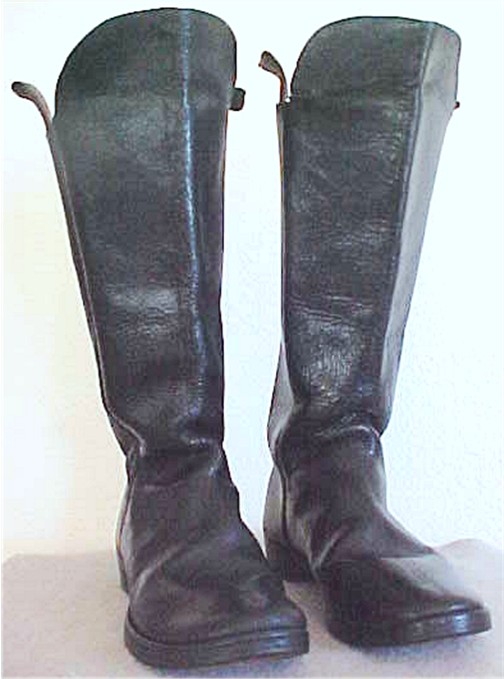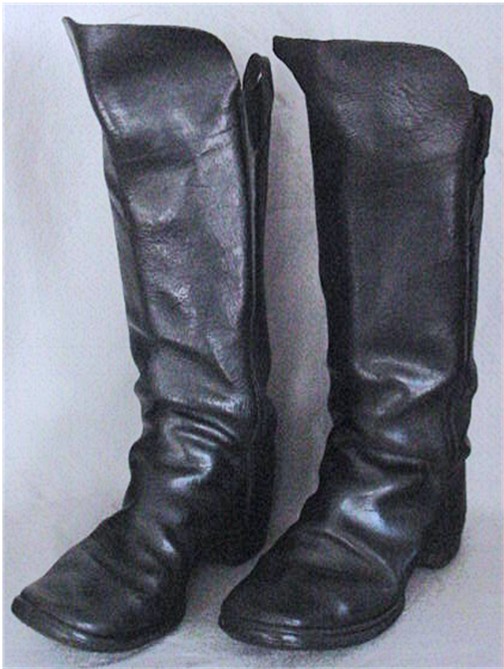|
PATTERN 1876 CONTRACT US ARMY MOUNTED TROOPER’S
BOOTS – VERY ATTRACTIVE PAIRS IN EXCELLENT CONDITION:
These are excellent pairs of US Army Pattern 1876 Boots
as worn by the mounted enlisted men during the height of
the Indian War period.
One of the little known side bars in the story of the
footwear worn by the soldiers in the 19th
Century army, these Pattern 1876 Contract US Army Boots
for Mounted Soldiers represent one of the evolutions of
development as the army sought a serviceable, durable
and comfortable boot for the troops. Thanks to the
research and efforts of Sidney Brinckerhoff, this often
overlooked boot pattern is documented in his detailed
monograph, Boots and Shoes of the Frontier Soldier.
While the circumstances are not entirely clear, it is
known that in the mid-1870’s the army was experiencing
difficulty in settling on a serviceable pattern of boot
and producing sufficient quantities to maintain a steady
supply. Whatever the reason, in October of 1875 the
Acting Quartermaster General of the Army ordered an
“emergency purchase” on the open market of 10,000 pairs
of boots, to be obtained under contract from four
civilian manufacturers. Two of the contractors
successfully fulfilled their orders, but due to the
Quartermaster relaxing certain standards in order to
ensure the contracts were filled in a timely manner, the
boots provided by the other two contractors were
rejected upon delivery due to inferior workmanship and
quality. A subsequent board of officers convened to
review the situation decided to acquire the rejected
boots – apparently still required in order to meet the
needs of the army – but at a reduced price. While the
exact specifications of these contract boots are not
known, they generally followed those of the Pattern of
1876 Mounted Boots.
Fortunately, Brinckerhoff provides photographs of two
pairs of these Pattern 1876 Contract Boots in the above
cited reference.
Keeping in mind that the emergency procurement order
went to four contractors, and that certain standards
were relaxed, a degree of difference between each maker
is not only normal, but is to be expected.
Soldiers’ footwear is generally not something that
survived his period of service, or his post-military
life, in great numbers – in most cases, these boots were
simply too utilitarian to be saved. Comparatively
little US Army 19th Century footwear survives
today and even fewer examples of mounted soldier’s boots
in any condition are available for purchase by the
private collector. The 1876
Contract Mounted Soldier’s
Boots offered here present as prime examples of
the footwear that bore the Frontier Army across the
American West on any of the famous campaigns during the
height of the Indian Wars.
While anything but common, I am fortunate enough to be
able to offer the two pairs of 1876
Contract Mounted Soldier’s
Boots, each described in detail below with accompanying
photographs.
|
|
NO. 1
PATTERN 1876 CONTRACT US ARMY MOUNTED TROOPER’S
BOOTS – A VERY ATTRACTIVE PAIR IN EXCELLENT CONDITION:
The pair of boots offered here substantially matches the
style, pattern and design of the those two reference
pairs pictured by Brinckerhoff in the above cited
reference.
The front upper of each boot has the fold crease running
from the toe to the top of the boot, another
characteristic of these 19Th Century US Army
boots. This fold served some purpose during the
manufacturing process, perhaps to center the boot on the
last prior to stitching the upper to the sole. The boot
tops are of the diameter of the Pattern 1876 produced by
the army, increased from the diameter of the Civil War
boots and still again larger than that of the Pattern
1872 Boots in order to better accommodate the wearing of
the soldier’s pant legs inside the boot tops.
In excellent
condition, the boots are made with a one
piece front and one piece back, sewn along the sides
with a reinforcing welt to protect the stitches.
The leather on
both boots is supple, has not hardened, and the finish
is overall excellent. The
uppers are intact with
none of the holes, cracks, splits, open
seams or other damage associated with heavy wear, with
the exception of a small wear point at the bottom of the
right side of the upper “knee lobe” on the left hand
boot, and a small wear point on the top rear edge of the
right boot. Both boot pulls are present on both boots,
all still strong and supple with no weak points.
The
original soles and heels show minimal wear. Both
boots are stamped with the numerals 10 and 3. I
assume, given the length of the boots, the "10"
indicates the size and the "3" may be a unit
identification stamp.
That this pair of boots survives today in the
excellent condition they do is nothing short of
remarkable. Capturing the character of the frontier
soldier who wore them, this pair of boots will be a
historic addition to your Indian War Cavalry display.
(0409) $1875
 |
|
NO. 2
PATTERN 1876 CONTRACT US ARMY MOUNTED TROOPER’S
BOOTS – AN ATTRACTIVE PAIR IN VERY GOOD CONDITION:
The pair of boots offered here substantially matches the
style, pattern and design of the those two reference
pairs pictured by Brinckerhoff in the above cited
reference.
The front upper of each boot has the fold crease running
from the toe to the top of the boot, another
characteristic of these 19Th Century US Army
boots. This fold served some purpose during the
manufacturing process, perhaps to center the boot on the
last prior to stitching the upper to the sole. The boot
tops are of the diameter of the Pattern 1876 produced by
the army, increased from the diameter of the Civil War
boots and still again larger than that of the Pattern
1872 Boots in order to better accommodate the wearing of
the soldier’s pant legs inside the boot tops.
The boots are made with a one
piece front and one piece back, with a heavier "heel
counter" sewn at the bottom of the back panel. The
seams along the sides
are sewn with a reinforcing welt to protect the stitches.
The leather on
both boots is supple, has not hardened, and the finish
is overall excellent.
This
pair of boots shows evidence of
having been worn in the field. The
uppers of both boots
are very nice and intact with
none of the holes, cracks, splits, open
seams or other damage associated with heavy wear.
The right boot is missing the outside pull loop and
there is a half-moon shaped piece of leather missing
from the center of the top rear edge of the upper.
The shape of the missing piece and that it is located in
the center of the back panel's top edge, these is little
doubt that it was intentionally cut out by the soldier
in order to relieve a spot where the edge was wearing
against his leg, possibly the site of a previous injury
or wound.
The top of the outside corner of the back panel of the
left boot has a triangle of leather
pieced in under the finger pull, and at first glance it
appears as an old repair. Once again, Brinckerhoff’s
research reveals that this piece of leather was not a
repair, but rather part of the original manufacturing
process. On page 13, he shows a pair of what he
describes as “1876 officer’s quality [boots]”, and the
left boot of that pair shows this same triangular piece,
sewn in the same manner, in the same location as on the
right boot of this pair. During the Indian War era,
finances were a constant source of concern and the army
made every effort to conserve expensive commodities such
as leather. When the patterns were laid out on the
hides for cutting, that the pattern extended past the
edge of the hide for this small amount would not have
been sufficient for the cost-mindful workers to discard
the hide. Rather, they simply cut a piece to fill the
void and stitched it in place. At this place on the
boot, such an addition would not compromise the comfort,
strength or durability of the boot, nor did it affect
the appearance.
After discovering this feature and finding the
photograph of the second pair, I realized I had seen
this same pieced-in treatment on an item in my personal
collection. Years ago I purchased a Northern Plains
beaded bag fashioned from what I recognized at the time
of purchase as two pieces of army boot top leather. The
bag, measuring 10” long by 6” high, is sewn with sinew
around the bottom and the sides, and is then beaded
along those edges and along the open top. The stitching
pattern of the boot pulls (which were removed) is
visible in the waxed calf black leather, and there is no
doubt the maker of the bag salvaged the leather from a
pair of high topped boots. While the balance of the
stitching on the bag is all hand done with sinew, and
definitely of the period, there is a short 2” section of
machine stitching, like the stitching which at one time
anchored the boot pulls, where a triangular piece of
leather was added to the main piece. Before
understanding that these additions were commonly
executed in the manufacture of these boots, I had no
context to understand this small stitched piece on the
bag, but now this small triangular patch further
explains the history of this bag as having been made
from tops of a pair of Indian Wars era army boots.
Both boots were resoled and heeled during their service
life, with the heel caps being set with square headed
nails and the half soles set with wooden pegs. The
boots were then heavily worn subsequent to these
repairs, the wear particularly notable under the ball of
each foot. It is worthy to note that the ball of
the feet, and therefore the specific wear spots on these
soles, are the exact points where a soldier's feet would
rest and chafe against the wooden tread of his stirrups
- indicating this cavalry trooper rode many miles in
these boots. He continued to wear these boots
after he wore through the half soles, and the wear
continued up into the first full layer of sole leather
on both boots, exposing a section of the stitching which
were applied when the boots were originally made.
The openings created by this additional wear would have
allowed dirt, water, mud and snow in which would have
caused him considerable discomfort, but the necessity of
his situation required him to continue to wear them.
I suspect that once he returned to the post after that
campaign, this pair of boots were considered too far
gone to bother repairing, and he received a new pair.
That alone may be the reason this pair has survived in
the unaltered condition which they have.
That this pair of boots
were not discarded, and survived to exist in the
collector's market today, presents a good opportunity to
acquire an
excellent example of US Army footwear as they existed on
the frontier. This pair certainly illustrates the
true living and clothing conditions of the Indian Wars
cavalry
soldier who wore them, and they will be an evocative addition to your Indian War Cavalry display.
(0928) $1575
 |

